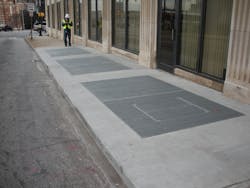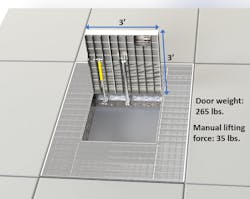Push for Undergrounding Drives Advances in Vault Covers
Utilities across the U.S. are moving toward underground installation. Undergrounding improves street views, minimizes weather damage and reduces wildfire risk while protecting vital infrastructure. The rise of undergrounding highlights a growing need for reliable, safe and effective utility vault covers. New covers provide innovative solutions for safety, compliance, and access, enhancing construction projects and protecting utility companies from liability.
Public safety is a primary concern for electric utilities. However, existing vault covers do not always meet current requirements for vehicle loading and pedestrian protection. New covers should be designed to comply with American Association of State Highway and Transportation Officials’ (AASHTO) H-20 vehicular loading requirements and Americans with Disabilities Act (ADA) guidelines.
AASHTO H-20 vehicular classification refers to an axle load of 32,000 pounds or wheel load of 16,000 pounds. Vehicles in this category include fire trucks, emergency vehicles, sanitation trucks, concrete trucks and delivery vans. Hazardous conditions result from these types of vehicles driving onto a sidewalk and damaging improperly rated bar grating or solid plate covers.
Damaged covers might go unnoticed until a pedestrian or worker trips, slips or falls, resulting in injury. Installing robust products specifically designed to withstand heavy vehicular loads can prevent these hazards from occurring.
New vault covers are also manufactured to meet or exceed current ADA guidelines for pedestrian safety. These guidelines stipulate that the gap between grating surface bars should not exceed 1/2 inch. Grating covers can surpass this requirement with an even smaller gap of 5/16 or 1/4 inch, which is ideal for bicycles and high heels. The percentage of open area ranges from 52% to 76% which typically complies with airflow cubic feet per minute (CFM) requirements for underground subway ventilation and heat emitting utilities like transformers. This promotes safety for pedestrians as well as for critical equipment.
Limiting Liability with High Traction
ADA guidelines for pedestrian safety also require walking surfaces to meet current traction standards, which is vital for limiting liability. Each year, slip and fall injuries in the United States account for approximately $60 billion in medical and work loss costs, according to the Centers for Disease Control and Prevention. Additionally, each incident costs $48,000 on average and results in 14 lost workdays (National Safety Council). This is a risk that utility companies cannot afford to ignore.
New grating covers address ADA traction standards in two ways. First, by spanning the surface bars perpendicular to the predominant path of pedestrian traffic, which maximizes the surface’s inherent traction capabilities.
Second, by applying a metal traction surface that dramatically increases slip-resistance. The degree to which a surface resists slippage is measured as the dynamic coefficient of friction (DCOF). DCOF is tested on wet surfaces and measured on a scale of zero, the lowest traction, to one, being the highest traction. The American National Standards Institute (ANSI) A326.3-2021 / Hard Surface Test Standard establishes a minimum wet DCOF of 0.42 for acceptable traction.
Traditional traction-enhancing products include paint-on sand and epoxy mixed with a fine aggregate. These older applications provide some initial benefit but lose slip-resistance over time as the material degrades due to wear and environmental factors. A superior alternative is an applied metal traction surface with wet DCOF averages that greatly exceed 0.42. Two of the most effective metal traction application methods are thermal spray and laser deposition.
Thermal spray affixes molten metal to the base surface to create a sandpaper-like texture. Laser deposition uses CNC technology to weld individual traction features onto the surface metal. Both applications bond with metal bar grating or plate to achieve long lasting durable slip resistance.Choosing the right traction safety product ensures that vault covers will exceed industry requirements and ADA guidelines while protecting companies from excessive liability costs.
Smart Access with Lift Assist
Vault cover safety is just as vital for field workers as it is for the public. This begins with ensuring that vaults are easily accessible for maintenance and repair. When vaults are covered by massive concrete slabs that are only removeable by crane, it impedes worker access and prompts road or sidewalk closures that result in excessive time delays. Metal covers also present a challenge and risk of injury due to the substantial lifting force required to open heavy access hatch doors.
Utility vault covers with lift assist technology provide an innovative, ergonomic solution. An integrated lift assist system prioritizes worker safety and simplifies access by dramatically reducing or eliminating the lifting weight of access hatch doors. Lift assist systems can be equipped with either compression spring cylinders or electric linear actuators.
Compression spring cylinders work by counterbalancing the weight of access doors. Using the system pictured at the right, a worker can open a 265-pound door with only 35 pounds of actual lifting force. Spring cylinders prove more effective and reliable than gas filled or pneumatic cylinders, especially in cold weather conditions. They are made from stainless steel, ensuring they are non-corrosive and extremely durable. Cylinders can be easily removed or replaced by unbolting the top and bottom stainless steel hardware assemblies.
To enter a vault, workers unlock the hatch door, grasp the integrated handle, and easily raise it with lift assist. A steel locking safety bar automatically secures the hatch door in its fully vertical position, streamlining access while work is being completed. For added safety, hatches can be equipped with a removable light duty safety grate to protect against falls. Innovative collapsible folding barriers can also be integrated as another precaution. When exiting the vault, workers manually disengage the locking safety bar, allowing the lift assist system to gradually lower the hatch door. Once closed, it is secured with a locking mechanism.
Electric linear actuators easily manage access hatch doors of any size or weight with no manual lifting. Actuators can be installed in both bar grating and solid plate doors. The door pictured above is a 1,000-pound solid plate access hatch. To open the hatch, workers unlock an access panel and plug in a door controller. With the press of a button, the hatch raises to its fully vertical position, where it remains secured until work is completed. After lowering the hatch and locking the access panel, the door controller is stowed safely in the utility vehicle.
Building for the Future
In new construction, proactive utility companies are revising their standards for vault covers to comply with pedestrian safety guidelines and vehicular loading requirements. There are two options for new vault covers: solid metal plate and metal bar grating. Vaults use solid tops for utilities that do not require airflow, such as water, gas, cable, or fiber optics. Metal bar grating is necessary for subway ventilation grates and heat generating utilities such as transformers. Vault cover solutions can be customized with a combination of plate and grating elements to meet unique design needs.
New covers can also be retrofit into preexisting frames. This helps property owners prioritize safety by replacing damaged or deteriorating vault covers before they become problematic. If the preexisting frame is too shallow, the cover’s deeper structural bearing members can be coped to fit the specifications of the frame.
For vault top replacements, the original vault remains in place while the top portion of the vault walls and cover are changed. New galvanized steel frames are installed with concrete poured around the perimeter. Once the frame is set, the new properly rated vault cover is placed inside. Replacing or retrofitting vault covers is much more cost effective than a complete vault replacement and greatly reduces the annual cost of maintenance.
Ohio Gratings, Inc. partnered with the Southern Company to complete one such vault top replacement in downtown Atlanta, Georgia. In this case, the existing vault was covered with concrete slabs that did not allow adequate ventilation for the transformer underneath. The few areas that were ventilated utilized a light duty grating product that was neither ADA compliant nor AASHTO H-20 rated. This presented a logistical and liability problem for the company. Ohio Gratings worked closely with the Southern Company’s standards engineers to identify utility requirements and develop solutions that included new frames, grating, and access doors. “This was a collaborative effort,” said product engineer Aristotle Zournas. “The resulting covers are fully compliant, provide the appropriate percentage of open area for ventilation, and are properly rated for potential heavy vehicle loads.” The new installation is virtually maintenance-free and creates a much safer environment for pedestrians and workers in Atlanta.
Once the solution was implemented, frames and grating panel sizes were standardized for use in future projects. Standardization allows the Southern Company to maintain a consistent vault size throughout the city, streamlining vault cover replacement and new construction.
Brian Pelto ([email protected]) serves as the specialty products sales manager for Ohio Gratings, Inc. Pelto’s team serves the Bridge & Transportation, Park & Recreation, and City Sidewalk markets. His experience includes working with customers and clients including utility engineers, DOT engineers, precast firms, utility contractors, and architects to provide solutions for over 28 years. He is an Ohio Gratings member representative to the National Precast Concrete Association and California Precast Concrete Association, and a vendor representative the Western Underground Committee.
Kevin Miller, P.E. ([email protected]) serves as the vice president of business development for Ohio Gratings, Inc. He is a licensed Professional Engineer who has partnered with customers and clients to provide strategic solutions for over 30 years. His experience includes civil and structural engineering, product design, and creating partnerships and solutions that provide positive results. He is a member of the American Society of Testing and Materials and the Transportation Research Board, serving on multiple research and standard committees.
About the Author
Kevin Miller
Kevin Miller, P.E. serves as the Director of Business Development for Ohio Gratings, Inc. He is a licensed Professional Engineer who has partnered with customers and clients to provide strategic solutions for over 30 years. His experience includes civil and structural engineering, product design, and creating partnerships and solutions that provide positive results. He is a member of the American Society of Testing and Materials and the Transportation Research Board, serving on multiple research and standard committees. Kevin can be reached at [email protected].
Brian Pelto
Brian Pelto serves as the Specialty Products Sales Manager for Ohio Gratings, Inc. Brian’s team serves the Bridge & Transportation, Park & Recreation, and City Sidewalk markets. His experience includes working with customers and clients including utility engineers, DOT engineers, precast firms, utility contractors, and architects to provide solutions for over 28 years. He is an Ohio Gratings member representative of the National Precast Concrete Association, California Precast Concrete Association, and the Western Underground Committee. Brian can be reached at [email protected].




